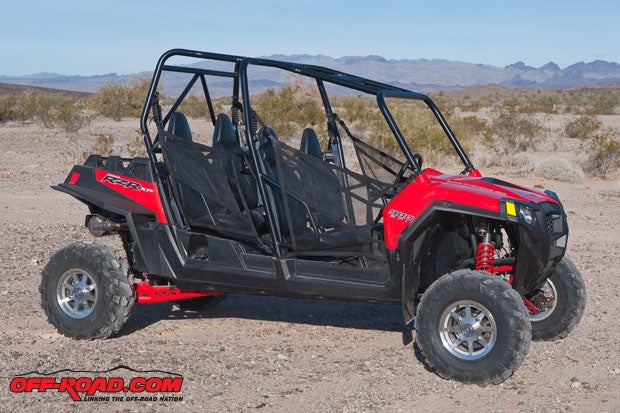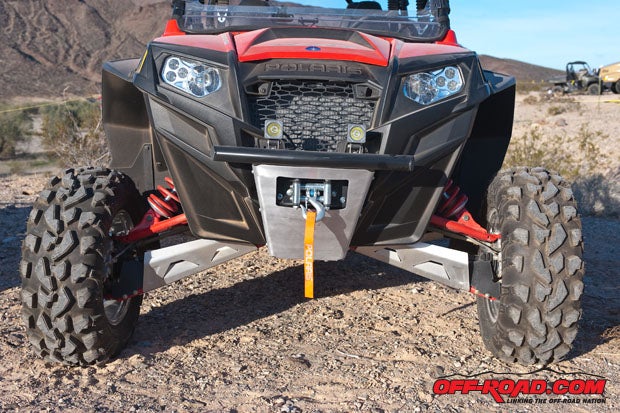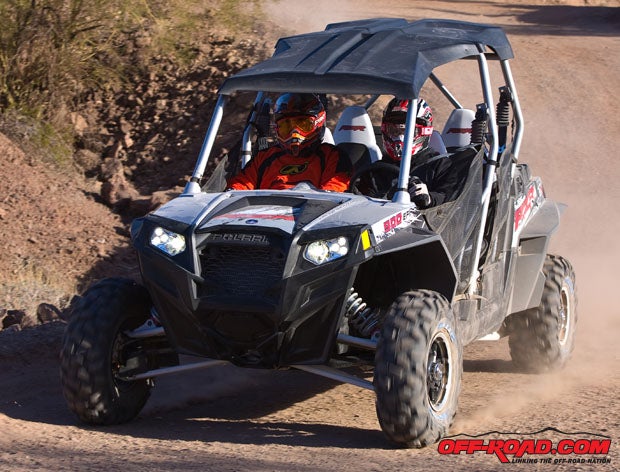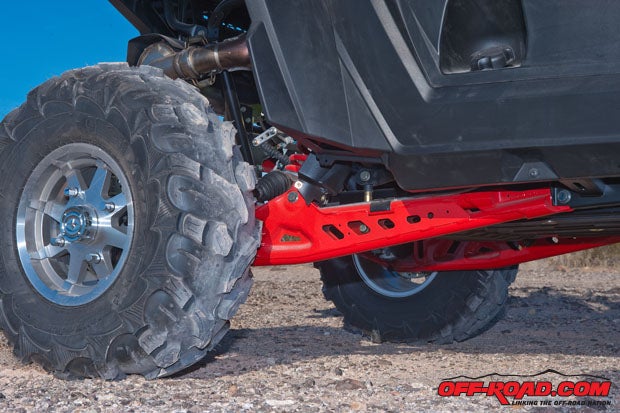
In 2008 the world of trail-capable, compact, high-performance side-by-sides was plagued like much of the powersports market with unsteady economic days. With one vision in mind a Medina, Minnesota, based company infused new product into the market that not only captured part of the recreational off-road market but set in motion one of the fastest-growing powersport waves that keeps gaining speed with every year that passes. The full line of Ranger RZR vehicles went against the grain by but bucking the trend of struggling sales, and it also offered options that offer fun for the entire family. Enter the Ranger RZR4 XP 900. The fastest family mover on the market!
Looking at the Polaris RZR4 XP 900 you will see many key features that were first introduced on last yearís RZR XP 900. When looking at the new RZR4 XP 900, the design is very close to the original XP 900 from the front. The view changes, however, when you step just off to the right or left. You will notice the 107.4-inch wheelbase that makes Polarisís new ride perfect for an additional two seats. This wheelbase not only lends itself well to the added seating configuration but it also adds stability to the high-flying, super-powered chassis. The rear seats are set just a bit higher than the front, giving the passengers a little better of the trail. The rear seats of the RZR4 XP 900 feature a comfortable-yet-rugged setup featuring the same anti-cinch shoulder seatbelts to keep passengers safe and comfortable.

Propelling the 2012 Polaris RZR4 XP 900 down the trail is the Prostar 900 engine. This brutal four-stroke, twin-cylinder powerplant has kicked the off-road community in the seat of its pants with its powerful 88-horsepower engine. This engine was designed to be not only solid as a rock but to give the driver something to smile about. With a dual-overhead cam head design and four valves per cylinder, the combustion chamber is alive and begging for fuel, air and ignition. The dual throttle bodies feed fuel to the fire, and with the volume of air and fuel coming into the 895cc platform thereís bound to be loads of fun.

To deliver power from the motor meant Polaris needed a stout transmission, so it was a no brainer to couple the XP 900 tranny to the 895cc mill. The bulletproof transmission is lightweight and compact, and it also transfers the power delivered from the CVT belt via the engine to usable ground-pounding torque Ė and with quickness, I might add. This gearbox is specially designed to transfer and accept the high spike loads that will be experienced when running hard through rough and uneven terrain. The RZR4 XP 900 also comes with On Demand true all-wheel-drive for the trails that havenít seen humans in a few years, meaning you can get home by going over the mountain instead of around it. When you have a machine like the RZR4 XP 900 that travels fast and handles the surrounding terrain like a Baja buggy, you have to know there had to be some tough links between the driverís right foot and the ground beneath the tires.

On the 2012 Polaris RZR4 XP 900 you will find Walker Evans shocks that are compression and preload adjustable. The shock setup is the same suspension found on the XP 900. There is also a slight change in the size of the rear shock to accommodate for the extra load of two more screamers. The front shocks have a two-inch body while the rear are 2.5 inches for added oil volume to help control the heat generated during the incredible 14 inches of rear wheel travel and the added passenger weight. The standard 2.0-inch Walker Evans shocks up front will be compression and preload adjustable as well, and the front travel is still an amazing 13.5 inches.

Our press ride featured the option of driving the LE (limited edition) model of the new RZR4 XP 900. The limited-edition package not only offers electronic power steering, but also Maxxis Big Horn tires, and a liquid-silver color and trick new graphics. The electronic power steering made the rocks and g-outs a little more manageable in the tough areas during our ride. See, we actually had the day to explore the Parker 250 racecourse, or at least 20 miles of it after it had been thoroughly thrashed by the race drivers just a few days before.
With two days to check out the terrain before we rode the RZR4 XP 900 the anticipation was incredible. On Monday, the sun brought us to a windy and very cool ride location where Polaris had brought out a fleet of XP 900s to chase over 20 editors through the desert of Parker Arizona. The line of RZR4 XP 900s seemed endless, and with just a few glances we found our designated ride for the day.
Getting seated in the RZR4 XP900 I immediately noticed the comfortable seating and the tilt steering. Being able to adjust the steering wheel is a great feature, and it sure makes it easier for a bigger guy to get in and out. When I started the Prostar 900 it brought back memories from our XP 900 at home. The same snappy throttle made all other concerns fly away and it was time to roll. Although it had lost just a touch of pep primarily due to the extra weight and length of the machine, the RZR4 XP 900 meet the expectations I had envisioned when looking back at our XP 900 at home.

The power is delivered without fail to the rear wheels in a fluid and smooth connection that makes smooth takeoffs a cinch. The electronic power steering kept my mind in check as it gave me free pass after free pass by reducing g-forces from nudging local rock formations. This EPS also made controlling the RZR4 XP 900 very comfortable and it inspires confidence in the type of terrain where we had been riding. With the extra seats behind me begging for passengers I set out to find some other editors to fill the seats and get and idea of what the ride would be like for the driver as well as his passengers. The Walker Evans shock seemed to be set a bit soft for our full crew, so we adjusted the compression up just a little to see if the harsh bumps would fade just a bit. The conclusion we made was that quite possibly we needed just a bit more preload or a heavier spring instead. Although we were able to bottom the machine, it was most certainly under high speed in the roughest terrain.
As far as the handling of this Polaris goes, it was incredibly stable and seemed to perform better at higher speeds. The extra length really lent itself to more controlled flight through really whooped-out sections of the trails. The larger passengers did have to straddle the front seats a bit, but it is not uncomfortable at all. The full width handhold for the back seats gave the riders something to hold on to in the wacky rutted and whooped sections.
Overall the RZR4 XP 900 ran flawless and the only trouble we had was a flat tire on the right rear. The Maxxis Big Horns are tough and proven so itís amazing how quick the desert boulders can bite through the rubber sidewall. Then again, we were on a racecourse so itís not surprising we found a large rock. If I had to say one last line, this isnít just another complete package from Polaris, it is an advanced, well-thought-out plan to conquer the world of off-road side-by-side powersports fun. Now go get one and take your friends with you!!
RS


 Your Privacy Choices
Your Privacy Choices